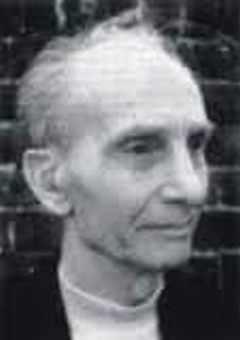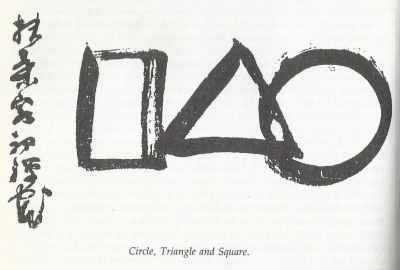SelfDefinition.Org
Selections from
Taste for Things That Are True
Henri Tracol

Esta página en español: gusto-por-las-cosas-que-son-verdaderas.htm
From chapter 3: "A Born Seeker", pages 24-27.
Source of PDF (English): b-ok.lat/book/
... At such a moment the call to search resounds in him and hope is born in his heart. But woe betide him if he believes himself safe from now on. The vision does not last – perhaps it is not meant to last – and once more he is left with the dizzying impression of having sunk back into his own insoluble contradictions.
Feeling lost, he may lose himself further in his search for self-recovery; experiencing his blindness, he may increase it in trying to see; becoming aware of his slavery, he may let his very search for freedom fetter him still more.
Until suddenly he awakes anew, and the whole process begins again. In the long run, by trying and failing, over and over, he may come at last to attune himself to the specific part he has to perform in this enigmatic play.
Whenever a man awakes and remembers his purpose, he awakes to a fleeting miracle, and at the same time to an unanswerable riddle. He realizes, at moments, that in order for him to awake he was foredoomed to sleep; in order for him to remember, he was foredoomed to forget. Such is the law of this equivocal situation: without sleep, no awakening; without oblivion, no remembering. Hence, if he goes on looking for what is beyond ambivalence, it will prove to be merely another phantasm. In fact, there is, and always has been, a secret continuity in his being, which is partly reflected in the unchanging structure of his body and the regularly recurring activities of its functions. But in a perpetually moving world of energies, such a relative continuity can never be equated with immutability. The law of man's existence is to become – or to die. If a man were to stay still forever and merge into eternity, there would be little sense in his remaining here on earth.
Such is the human condition: a lucid and total acceptance of it is imperative. This alone will help the true searcher to reaffirm his inner determination. He must be ready to comply with a constantly shifting reality, ready to reconcile himself to the law of alternation, the law of successive turns of fate, ready to conform to whatever may be offered, either favorable or hostile, ready to reject all wishful thinking and to expect nothing in the way of result or reward.
Sooner or later, he will have to try, not only to accept risks, but to take up the challenge knowingly and put himself in jeopardy. Only then will he truly respond to the call. Far from abjuring the revelations accorded him through teachings he may previously have come in contact with, he longs to "verify" them – that is, to prove them true for himself here and now. Conscious participation in what is self-evident is the goal of the genuine searcher: a goal so close and at the same time so remote, a goal so constantly offered and again withheld – in order that he may keep on searching.
For a man, far beyond his personal hopes and predilections, to search is a sacred task, and if he assents to it and persistently endeavors to fulfill it, he will experience it as truly corresponding both to his essential needs and to his specific capacities.
Patience – much patience, endurance and determination, watchfullness and readiness, availability and conscious flexibility – all these are indispensable to the seeker.
Maybe the time will come when he realizes that in order to develop these latent potentialities he needs guidance and support. Freed from any pretension to be a "knower", he will deliberately put himself under the authority of a master. To absorb his teachings and follow his directives? Yes, and even more important, to perceive and to study the way he deals with life and people, to watch how he conveys his understanding through behavior and tone of voice, and, ultimately, to be able to receive his wordless glance.
By serving such an apprenticeship the seeker gradually unbinds himself from prejudice and becomes sensitive to a wide range of manifestations or testimonies of search, wherever he may happen upon them – and this regardless of any apparent inconsistencies he encounters between their respective features. He will realize that they all refer to the same Unknown that he himself confronts.

Sengai's drawing
With this in mind, one may ask oneself why Sengai's eloquent drawing has been chosen as the motif for this book. Does not this Zen picture appear as a concluding gesture to what must have been, for the artist, a lifelong search? We cannot help visualizing Sengai preparing himself – hours of meditation in perfect stillness – then the smooth and careful stirring of the ink, and the brush rises, remains for a moment suspended in the air like an eagle watching its prey, until, all of a sudden – lo – it is done!
Circle, triangle, square.
But what kind of a geometrician is this man? Look at his "square"! The inaccuracy of the lines, the faintness of the ink! But Sengai, obviously, does not care: ordinary exactitude is no part of his province. Clearly, he is more concerned with the inner relationship among the three symbols and the way they engender one another.
Their sequence in itself is a riddle. If we ponder upon it, we realize that it naturally flows from right to left. Following the movement of the brush, we complete the circle, leave it for the triangle, and finally vanish into the last stroke of the square.
For us, it may be difficult to accept this interpretation of the sequence, since according to our Western system of associations, we automatically see it moving from left to right. That is the way we are trained to "read" things, reaching always towards the full stop and the closing of the circle.
There exist, in fact, reliable hints as to Sengai's probable intention. Professor D. T. Suzuki, the noted authority on Zen Buddhism, has suggested that the circle represents formlessness, emptiness or the void where there is yet no separation of light and darkness; the triangle evokes the birth of form out of formlessness; and the square, as a combination of two opposite triangles, stands for the multiplicity of things.
From the infinite oneness down to the inexhaustible variety of forms in which it divides itself, from the secrecy of Essence to the ever-springing Manifestation, here lies the mystery of involutive Creation.
But should we rest satisfied with Suzuki's marvelously condensed vision as the only reliable one? Or would such an easy consent not, in a sense, betray both painting and comment? Rather, we should keep our minds open to the flow of suggestions that comes from other sources, for instance the "squaring of the circle" of the Alchemists – and even those that may arise from our own inner recesses – while making sure that we do not fall under the spell of any them.
Are we now ready to transcend the dangerous fascination of apparent contradictions?
Let us ponder the order given to the three sections of Search and the way it has been designed to tally with the left-to-right pattern. Here again, we are faced with the law of alternation, for now is the time to climb back to the source. Having been exiled to this small, remote planet, where our only possible chance of survival requires the protective ramparts of material stability (square), we have to find our way laboriously to the discovery of direction, guidance and consistency (triangle) until we are ready for the ultimate quest – the return to the origin, the beginning (circle), from where ... but that is another story, or rather, perhaps the same story, the one everlasting story.
For the born searcher there is no escape from the labyrinth, Perhaps he will even realize that he himself is the labyrinth, and that no failure, no "answer" offered along the way, will ever stop him from moving further toward the centre of his own mystery. And, far from trying to evade the challenge, he will hope to become more and more able to meet it: this alone will confer meaning upon his search.
[ end of chapter ]